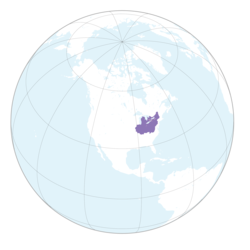Iroquois Confederacy Haudenosaunee | |
|---|---|
 Map showing historical (in purple) and currently recognized (in pink) Iroquois territorial claims | |
| Status | Recognized confederation, later became an unrecognized government[1][2] |
| Capital | Onondaga (village), Onondaga Nation (at various modern locations:
|
| Common languages | Iroquoian languages |
| Government | Confederation |
| Legislature | Grand Council of the Six Nations |
| History | |
• Established | Between 1450 and 1660 (estimate) |
The Iroquois (/ˈɪrəkwɔɪ, -kwɑː/ IRR-ə-kwoy, -kwah), also known as the Five Nations, and later as the Six Nations from 1722 onwards; alternatively referred to by the endonym Haudenosaunee[a] (/ˌhoʊdɪnoʊˈʃoʊni/ HOH-din-oh-SHOH-nee;[8] lit. 'people who are building the longhouse') are an Iroquoian-speaking confederacy of Native Americans and First Nations peoples in northeast North America. They were known by the French during the colonial years as the Iroquois League, and later as the Iroquois Confederacy, while the English simply called them the "Five Nations". The peoples of the Iroquois included (from east to west) the Mohawk, Oneida, Onondaga, Cayuga, and Seneca. After 1722, the Iroquoian-speaking Tuscarora people from the southeast were accepted into the confederacy, from which point it was known as the "Six Nations".
The Confederacy likely came about between the years 1450 CE and 1660 CE as a result of the Great Law of Peace, said to have been composed by the Deganawidah the Great Peacemaker, Hiawatha, and Jigonsaseh the Mother of Nations. For nearly 200 years, the Six Nations/Haudenosaunee Confederacy were a powerful factor in North American colonial policy, with some scholars arguing for the concept of the Middle Ground,[9] in that European powers were used by the Iroquois just as much as Europeans used them.[10] At its peak around 1700, Iroquois power extended from what is today New York State, north into present-day Ontario and Quebec along the lower Great Lakes–upper St. Lawrence, and south on both sides of the Allegheny mountains into present-day Virginia and Kentucky and into the Ohio Valley.
The St. Lawrence Iroquoians, Wendat (Huron), Erie, and Susquehannock, all independent peoples known to the European colonists, also spoke Iroquoian languages. They are considered Iroquoian in a larger cultural sense, all being descended from the Proto-Iroquoian people and language. Historically, however, they were competitors and enemies of the Iroquois Confederacy nations.[11]
In 2010, more than 45,000 enrolled Six Nations people lived in Canada, and over 81,000 in the United States.[12][13]
- ^ "Stateless Society | Encyclopedia.com". www.encyclopedia.com.
- ^ Morgan, Lewis Henry (1881). Houses and House-Life of the American Aborigines. Chicago and London: University of Chicago Press.
- ^ Dyck, Carrie, Froman, Frances, Keye, Alfred & Keye, Lottie. 2024. A grammar and dictionary of Gayogo̱hó:nǫˀ (Cayuga). (Studies of Amerindian Linguistics). Berlin: Language Science Press. DOI: 10.5281/zenodo.10473483. Pg 3 [1]
- ^ Cite error: The named reference
deerfieldwas invoked but never defined (see the help page). - ^ Woodbury, Hanni (2003). "Iroquois Confederacy". Onondaga-English / English-Onondaga Dictionary. Toronto: University of Toronto Press. p. 1182. ISBN 9781442623637.
- ^ Chafe, Chafe (2014). "Iroquois." (PDF). English-Seneca Dictionary. Onöndowa'ga:' Gawë:nö' (Seneca Language) Department. p. 88.
- ^ Rudes, Blair A. (2015). "Akunęhsyę̀·niˀ". Oneida–English/English–Oneida Dictionary. Toronto: University of Toronto Press. p. 42. ISBN 9781442628809.
- ^ Keh, Andrew; Kiehart, Pete (July 27, 2022). "How Indigenous Athletes Are Reclaiming Lacrosse". The New York Times. ISSN 0362-4331. Retrieved July 27, 2022.
Haudenosaunee (hoe-dee-no-SHOW-nee)
- ^ White, Richard (1991). The middle ground: Indians, empires, and republics in the Great Lakes region, 1650–1815. Cambridge. ISBN 0-521-37104-X. OCLC 22344887.
{{cite book}}: CS1 maint: location missing publisher (link) - ^ Barr, Daniel P. (2006). Unconquered : the Iroquois League at war in colonial America. Westport, Conn.: Praeger. ISBN 0-313-03820-1. OCLC 230726514.
- ^ Daeg de Mott 2009.
- ^ Marques, Nicole Terese Capton (2011). "Divided We Stand: The Haudenosaunee, Their Passport and Legal Implications of Their Recognition in Canada and the United States". Retrieved October 28, 2020.
- ^ "The American Indian and Alaska Native Population: 2010" (PDF). January 2012. Retrieved June 5, 2021.
Cite error: There are <ref group=lower-alpha> tags or {{efn}} templates on this page, but the references will not show without a {{reflist|group=lower-alpha}} template or {{notelist}} template (see the help page).
